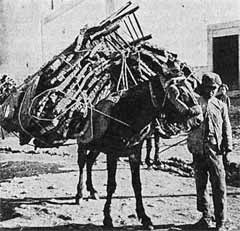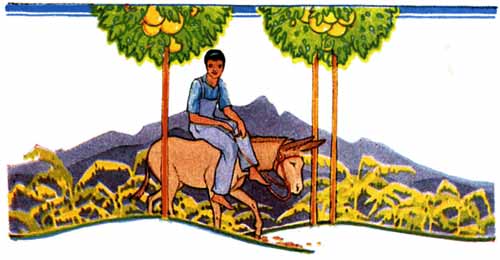|

 Inelegant Equid: Its short thick head, long ears, thin limbs, small narrow hooves, short mane, absence of chestnuts (horny growths) inside the hocks, and tail hairless at the root, all make the mule appear ridiculous. Inelegant Equid: Its short thick head, long ears, thin limbs, small narrow hooves, short mane, absence of chestnuts (horny growths) inside the hocks, and tail hairless at the root, all make the mule appear ridiculous.
In height and body, shape of neck and croup, uniformity of coat, and teeth, it appears equine. It has the voice neither of the donkey nor of the horse, but emits
a feeble hoarse noise. Most mules have a brown or bay-brown coat – bay, or bright bay, or piebald occur rarely; a chestnut tint sometimes appears.

A Horse of a Different Caliber: The mule possesses the sobriety, patience, endurance and surefootedness of the ass, and the vigor, strength and courage of the horse. Operators of working animals generally find mules preferable to horses: mules show less impatience under the pressure of heavy weights, while their skin, harder and less sensitive than that of horses, renders them more capable of resisting sun and rain. Many North American farmers with clay soil found mules superior as plow animals, especially in the U.S. state of Missouri, hence the expression "stubborn as a Missouri mule".
Work Horses: Humans have used mules for centuries; the inhabitants of Mysia and Paphlagonia allegedly bred the first  mules. The ancient Greeks, and especially Romans, valued mules for transport, using them to draw carriages and carry loads. In the 19th century, mules hauled barges on the Erie Canal and other North American and European canals, and mule teams were often used by teamsters on the U.S. Western frontier. In the early 20th century use of mules survived mainly in military transport, being used to haul caissons and artillery through nearly impassable terrain, the bravery and focused intelligence of the animal serving it well in the midst of the noise and confusion of warfare. mules. The ancient Greeks, and especially Romans, valued mules for transport, using them to draw carriages and carry loads. In the 19th century, mules hauled barges on the Erie Canal and other North American and European canals, and mule teams were often used by teamsters on the U.S. Western frontier. In the early 20th century use of mules survived mainly in military transport, being used to haul caissons and artillery through nearly impassable terrain, the bravery and focused intelligence of the animal serving it well in the midst of the noise and confusion of warfare.
Motor Car Vs. Mule: Mules have become far less common since the rise of the automobile, the motorized tractor, and other internal combustion-powered vehicles. Still, mules (and burros) can handle extremely rugged terrain and tracks that are too steep and twisted for either the less sure-footed horse or for a motor vehicle. Mules are also shown at equine shows.

Sterile but Sturdy: The mule, easier to breed and usually larger in size than a hinny, has monopolized the attention of breeders.
The chromosome match-up more often occurs when the jack (male donkey) is the sire and the mare (female horse) is the dam. It has been known for people to let a stallion (male horse) run with a jenny (female donkey) for as long as six years before getting her pregnant.
Mules are almost always sterile, as almost all hinnies are. The sterility is attributed to the different number of chromosomes the two species have: donkeys have 62 chromosomes, while horses have 64. Their offspring thus have 63 chromosomes which cannot evenly divide.
Mother Mule? A female mule, called a "molly", has estrus cycles and can carry a fetus, as has occasionally happened naturally but also through embryo transfer. The difficulty is in getting the molly pregnant in the first place.

All text is available under the terms
of the GNU Free Documentation License
|